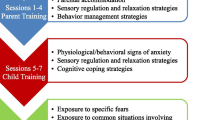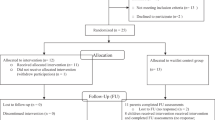Abstract
Objectives
Children with chronic illnesses may experience anxiety related to medical procedures and hospitalization, and they may lack coping strategies for managing this anxiety. The objectives of the current study were to implement a new anxiety management manual for children and use qualitative methods to examine how children personalized strategies from the manual. Parent perceptions of child coping also were examined.
Methods
Twenty-six children with chronic illnesses and twenty-five parents reviewed an anxiety coping manual focused on cognitive behavioral strategies of distraction, imagination, relaxation, and positive self-talk/thinking. Children reviewed the manuals with an interviewer and then they developed coping menus to reflect how they would use the cognitive and behavioral strategies from the manual. Parents also completed a survey to provide information about their child’s current coping and the strategies from the manual they thought their child was most likely to implement. Qualitative techniques were used to analyze data.
Results
Findings indicated that children had the ability to personalize coping strategies taught in the anxiety coping manual. Parents felt their children were most likely to use relaxation and distraction strategies. Parents reported that children had some pre-existing coping strategies, similar to those presented in the manual.
Conclusions
Children were developing personalized strategies for managing their anxiety, including distraction, imagery, relaxation, and positive self-talk. Parents, family members and pets were key support figures. Future research should explore whether children use the strategies over time, as they undergo repeated procedures and hospitalizations.

Similar content being viewed by others
References
Alderfer, M. A. (2017). Introduction to the special issue: Improving clinical practices in pediatric psychology through qualitative research. Clinical Practice in Pediatric Psychology, 5, 299–302. https://doi.org/10.1037/cpp0000222.
Compas, B. E., Jaser, S. S., Dunn, M. J., & Rodriguez, E. M. (2012). Coping with chronic illness in childhood and adolescences. Annual Review of Clinical Psychology, 8, 455–480. https://doi.org/10.1146/annurev-clinpsy-032511-143108.
Creswell, J. W. (1998). Qualitative inquiry and research design: choosing among five traditions. Thousand Oaks, CA: Sage.
Dahlquist, L. M., et al. (2002). Distraction for children of different ages who undergo repeated needle sticks. Journal of Pediatric Oncology Nursing, 19, 22–34. https://doi.org/10.1053/jpon.2002.30009.
Grey, M., Boland, E. A., Davidson, M., Chang, Y., & Tamborlane, W. V. (1999). Coping skills training for youths with diabetes on intensive therapy. Applied Nursing Research, 12, 3–12. https://doi.org/10.1016/S0897-1897(99)80123-2.
Hall, T. M., Kaduson, H. G., & Schaefer, C. E. (2002). Fifteen effective play therapy techniques. Professional Psychology: Research and Practice, 33, 515–522. https://doi.org/10.1037/0735-7028.33.6.515.
He, H.-G., et al. (2015). Therapeutic play intervention on children’s perioperative anxiety, negative emotional manifestation and post-operative pain: a randomized controlled trial. Journal of Advanced Nursing, 71, 1032–1043. https://doi.org/10.1111/jan.12608.
Kendall, P. C., Settipani, C. A., & Cummings, C. M. (2012). No need to worry: the promising future of child anxiety research. Journal of Clinical Child and Adolescent Psychology, 41, 103–115. https://doi.org/10.1080/15374416.2012.632352.
Koller, D., & Goldman, R. D. (2012). Distraction techniques for children undergoing procedures: a critical review of pediatric research. Journal of Pediatric Nursing, 27, 652–681. https://doi.org/10.1016/j.pedn.2011.08.001.
Law, E. F., Beals-Erickson, S. E., Fisher, E., Lang, E. A., & Palermo, T. M. (2017). Components of effective cognitive-behavioral therapy for pediatric headache: a mixed methods approach. Clinical Practice in Pediatric Psychology, 5, 376–391. https://doi.org/10.1037/cpp0000216.
Li, W. H. C., Chung, J. O. K., Ho, K. Y., & Kwok, B. M. C. (2016). Play interventions to reduce anxiety and negative emotions in hospitalized children. BMC Pediatrics, 16, 36–45. https://doi.org/10.1186/s12887-016-0570-5.
McCarthy, A. M., & Kleiber, C. (2006). A conceptual model of factors influencing children’s responses to a painful procedure when parents are distraction coaches. Journal of Pediatric Nursing, 21, 88–98. https://doi.org/10.1016/j.pedn.2005.06.007.
Miles, M. B., & Huberman, A. M. (1994). An expanded sourcebook: qualitative data analysis. 2nd Ed. Thousand Oaks, CA: Sage.
Nabors, L. (2006). Change the channel intervention manual for kids with arthritis. Cincinnati, Ohio: University of Cincinnati. Author.
Nabors, L., Liddle, M., Graves, M. L., Kamphaus, A., & Elkins, J. (2019). A family affair: supporting children with chronic illnesses. Child: Care, Health and Development, 45, 227–233. https://doi.org/10.1111/cch.12635.
Pao, M., & Bosk, A. (2011). Anxiety in medically ill children and adolescents. Depression and Anxiety, 28, 40–49. https://doi.org/10.1002/da.20727.
Patel, A., et al. (2006). Distraction with a hand-held video game reduces pediatric preoperative anxiety. Pediatric Anesthesia, 16, 1019–1027. https://doi.org/10.1111/j.1460-9592.2006.01914.x.
Peterson, L., & Shigetomi, C. (1981). The use of coping techniques to minimize anxiety in hospitalized children. Behavior Therapy, 12, 1–14. https://doi.org/10.1016/S0005-7894(81)80102-5.
Pinquart, M., & Shen, Y. (2011). Anxiety in children and adolescents with chronic physical illnesses: a meta-analysis. Acta Paediatrica, 100, 1069–1076. https://doi.org/10.1111/j.1651-2227.2011.02223.x.
Reigada, L. C., et al. (2013). Integrating illness concerns into cognitive behavioral therapy of children and adolescents with inflammatory bowel disease and co-occurring anxiety. Journal for Specialists in Pediatric Nursing, 18, 133–143. https://doi.org/10.1111/jspn.12019.
Stein, R. E. K., & Jessop, D. J. (1982). A noncategorical approach to chronic childhood illness. Public Health Reports, 97, 354–362.
Strauss, A., & Corbin, J. (1990). Basics of qualitative research: grounded theory procedures and techniques. Newbury Park, CA: Sage Publications.
Uman, L. S., Chambers, C. T., McGrath, P. J., & Kisely, S. (2008). A systematic review of randomized controlled trials examining psychological interventions for needle-related procedural pain and distress in children and adolescents: an abbreviated cochrane review. Journal of Pediatric Psychology, 33, 842–854. https://doi.org/10.1093/jpepsy/jsn031.
Wagner, J. L., Smith, G., Ferguson, P., van Bakergem, K., & Hrisko, S. (2010). Pilot study of an integrated cognitive-behavioral and self-management intervention for youth with epilepsy and caregivers: Coping Openly and Personally with Epilepsy (COPE). Epilepsy & Behavior, 18, 280–285. https://doi.org/10.1016/j.yebeh.2010.04.019.
Acknowledgements
Thanks are extended to Myia Graves for her assistance with coding information on the child menus. Appreciation is also extended to the parents and children who volunteered for this study.
Author Contributions
L.N. and J.E. deigned the study, wrote the manual and menu, and executed this study. L.N., C.S., and A.C. performed data analyses and contributed to writing this study.
Author information
Authors and Affiliations
Corresponding author
Ethics declarations
Conflict of Interest
The authors declare that they have no conflict of interests.
Ethical Approval
All procedures performed in the study involving human participants were in accordance with the ethical standards of the University of Cincinnati and/or national research committee and with the 1964 Helsinki declaration and it later amendments or comparable ethical standards.
Informed Consent
This study was approved as non-human subjects research and conducted in accordance with standards for such research at the University of Cincinnati. Informed permission and assent was obtained from all parents and children who participated in this study.
Additional information
Publisher’s note: Springer Nature remains neutral with regard to jurisdictional claims in published maps and institutional affiliations.
Rights and permissions
About this article
Cite this article
Nabors, L., Odar Stough, C., Combs, A. et al. Implementing the Coping Positively with My Worries Manual: A Pilot Study. J Child Fam Stud 28, 2708–2717 (2019). https://doi.org/10.1007/s10826-019-01451-3
Published:
Issue Date:
DOI: https://doi.org/10.1007/s10826-019-01451-3




